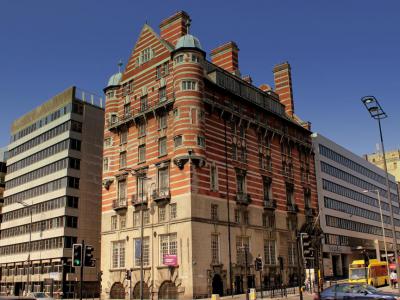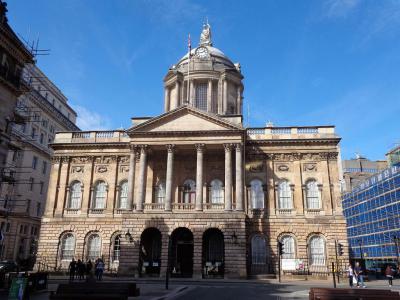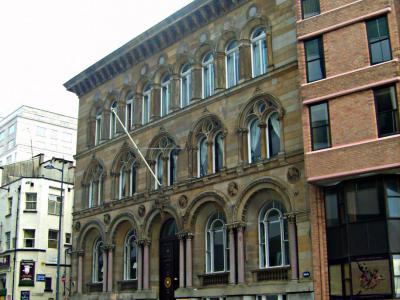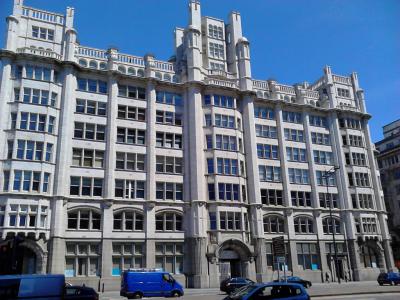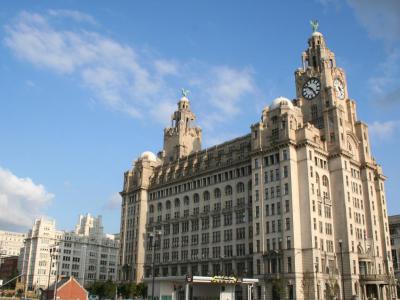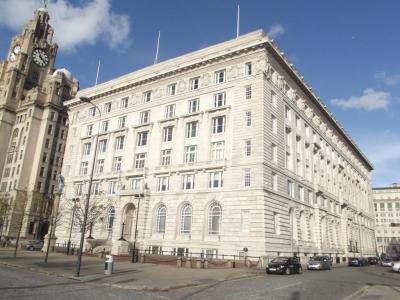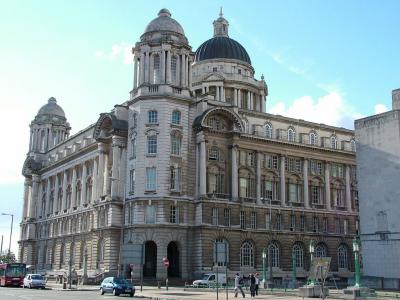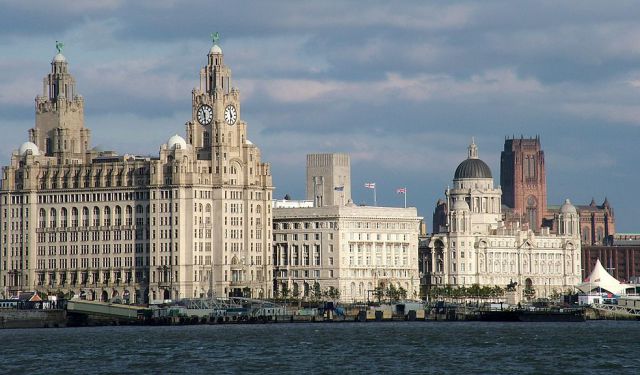
Liverpool Historical Sites Walking Tour (Self Guided), Liverpool
For a city steeped in history and culture as much as Liverpool, it is only natural to have many historical sites illustrative of its glorious past. Three of Liverpool's most remarkable buildings, collectively known as the Three Graces of Liverpool, are situated in the Pier Head. These include the Royal Liver Building, the Cunard Building, and the Port of Liverpool Building.
The distinguished Royal Liver Building, with its Liver Birds perched on top, is a symbol of Liverpool's commercial prowess and maritime trade. Adjacent to it, the Cunard and the Port of Liverpool Buildings further highlight the city's significance as a major port and gateway to the world.
Another emblem of Liverpool's maritime heritage, the Albion House, once served as the headquarters of the White Star Line, the company behind the Titanic.
The imposing Town Hall, with its magnificent neoclassical architecture, symbolizes the city's civic pride and governance. Its central portico, Corinthian columns, and a lead dome adorned with a statue of Minerva make it one of the finest examples of 18th-century town halls.
Oriel Chambers, hailed as the world's first metal-framed glass curtain-walled building, showcases Liverpool's pioneering spirit in architecture. Meanwhile, the Hargreaves Building is a prime example of Victorian-era architecture, reflecting the city's industrial prosperity during that time.
As for the Tower Building, it's a 1910 reconstruction of the mansion that stood on this site since the mid-13th century, and it's now serving as a blend of retail and residential spaces.
Each of these historical landmarks offers visitors a unique insight into Liverpool's past and allows them to appreciate its enduring impact on the world stage. So, care to embark on this self-guided walk and discover the stories etched within the city's iconic buildings!
The distinguished Royal Liver Building, with its Liver Birds perched on top, is a symbol of Liverpool's commercial prowess and maritime trade. Adjacent to it, the Cunard and the Port of Liverpool Buildings further highlight the city's significance as a major port and gateway to the world.
Another emblem of Liverpool's maritime heritage, the Albion House, once served as the headquarters of the White Star Line, the company behind the Titanic.
The imposing Town Hall, with its magnificent neoclassical architecture, symbolizes the city's civic pride and governance. Its central portico, Corinthian columns, and a lead dome adorned with a statue of Minerva make it one of the finest examples of 18th-century town halls.
Oriel Chambers, hailed as the world's first metal-framed glass curtain-walled building, showcases Liverpool's pioneering spirit in architecture. Meanwhile, the Hargreaves Building is a prime example of Victorian-era architecture, reflecting the city's industrial prosperity during that time.
As for the Tower Building, it's a 1910 reconstruction of the mansion that stood on this site since the mid-13th century, and it's now serving as a blend of retail and residential spaces.
Each of these historical landmarks offers visitors a unique insight into Liverpool's past and allows them to appreciate its enduring impact on the world stage. So, care to embark on this self-guided walk and discover the stories etched within the city's iconic buildings!
How it works: Download the app "GPSmyCity: Walks in 1K+ Cities" from Apple App Store or Google Play Store to your mobile phone or tablet. The app turns your mobile device into a personal tour guide and its built-in GPS navigation functions guide you from one tour stop to next. The app works offline, so no data plan is needed when traveling abroad.
Liverpool Historical Sites Walking Tour Map
Guide Name: Liverpool Historical Sites Walking Tour
Guide Location: England » Liverpool (See other walking tours in Liverpool)
Guide Type: Self-guided Walking Tour (Sightseeing)
# of Attractions: 8
Tour Duration: 1 Hour(s)
Travel Distance: 1.3 Km or 0.8 Miles
Author: irenes
Sight(s) Featured in This Guide:
Guide Location: England » Liverpool (See other walking tours in Liverpool)
Guide Type: Self-guided Walking Tour (Sightseeing)
# of Attractions: 8
Tour Duration: 1 Hour(s)
Travel Distance: 1.3 Km or 0.8 Miles
Author: irenes
Sight(s) Featured in This Guide:
- Albion House
- Town Hall
- Oriel Chambers
- Hargreaves Building
- Tower Building
- Royal Liver Building
- Cunard Building
- Port of Liverpool Building
1) Albion House
Albion House is situated in Liverpool’s historic docklands, on the corner of the Strand and James Street. Located next to the Pier Head and ferry terminals, Albion House was built in 1898 to house the headquarters of the city’s famous White Star Line shipping company. After relocating to the new building, White Star Line grew to become one of the world’s most famous shipping companies. It is however best remembered for the sinking of its ship, The Titanic, in 1912. Following the disaster, crowds gathered at Albion House as employees read the names of casualties from the balcony, too afraid to face the angry mob gathering below.
Albion House was designed by architects Richard Norman Shaw and J. Francis Doyle and closely resembles their first project, the Scotland Yard building in London. A grade II listed building, Albion House has a distinctive red and white striped façade, comprised of Portland stone and red brick – earning it the local nickname of the ‘streaky bacon’ building. The entrance hall features a mosaic of South America, a continent regularly visited by White Star Line ships. The shipping company merged with rivals Cunard Line in 1927 and relocated – Albion House is now a private office building.
Albion House was designed by architects Richard Norman Shaw and J. Francis Doyle and closely resembles their first project, the Scotland Yard building in London. A grade II listed building, Albion House has a distinctive red and white striped façade, comprised of Portland stone and red brick – earning it the local nickname of the ‘streaky bacon’ building. The entrance hall features a mosaic of South America, a continent regularly visited by White Star Line ships. The shipping company merged with rivals Cunard Line in 1927 and relocated – Albion House is now a private office building.
2) Town Hall
The Liverpool Town Hall, an architectural jewel of 18th-century England, is situated at the crossroads of High Street, Dale Street, Castle Street, and Water Street in Liverpool, Merseyside. Recognized as a Grade I listed building in the National Heritage List for England, it is celebrated as "one of the finest surviving 18th-century town halls."
Constructed between 1749 and 1754, the Town Hall was designed by John Wood the Elder to replace an earlier building nearby. An extension by James Wyatt in 1785 added grandeur, but a fire in 1795 led to extensive rebuilding, including Wyatt's distinctive dome. Over time, minor alterations have been made, and the surrounding streets were restructured, notably removing obstructing buildings to reveal the hall’s southern façade from Castle Street.
Unlike administrative buildings such as the nearby Cunard Building, Liverpool Town Hall serves as a civic suite. It houses the Lord Mayor's parlor, Council Chamber, and a Hall of Remembrance dedicated to Liverpool servicemen who perished in World War I. The opulent upper floor hosts events, functions, and weddings, with public tours offering a glimpse into its historical and decorative splendor.
The Town Hall, made of stone with a slate roof and lead dome, features a rectangular plan with a southern portico and Wyatt’s narrower northern extension. It has two stories, a rusticated basement, and façades with classical details. The south side has nine bays, a portico with rounded arches, and an upper balcony with Corinthian columns. The east and west façades have nine bays, plus three in Wyatt's extension, while the north includes five bays, a portico, and statues by Richard Westmacott from the Irish Houses of Parliament. Carvings above windows reflect Liverpool's trade history, and the dome, encircled by clock faces with lions and unicorns, is crowned by Minerva, a 10-foot statue symbolizing wisdom.
Liverpool Town Hall remains an enduring testament to the city's civic pride and Georgian architectural heritage, offering both a functional space and a visual marvel for visitors and locals alike.
Why You Should Visit:
Inside, visitors will find the grandest suite of civic rooms in the UK and a magnificent example of late Georgian decoration.
You also might want to go onto the balcony where the Beatles stood when returned to Liverpool.
Tip:
Guided tours inside are available, but check the opening times prior to the visit or just take photos from Castle Street.
Once the main business district, the area is now replete with bars and restaurants, so refreshments are only minutes away/opposite.
Constructed between 1749 and 1754, the Town Hall was designed by John Wood the Elder to replace an earlier building nearby. An extension by James Wyatt in 1785 added grandeur, but a fire in 1795 led to extensive rebuilding, including Wyatt's distinctive dome. Over time, minor alterations have been made, and the surrounding streets were restructured, notably removing obstructing buildings to reveal the hall’s southern façade from Castle Street.
Unlike administrative buildings such as the nearby Cunard Building, Liverpool Town Hall serves as a civic suite. It houses the Lord Mayor's parlor, Council Chamber, and a Hall of Remembrance dedicated to Liverpool servicemen who perished in World War I. The opulent upper floor hosts events, functions, and weddings, with public tours offering a glimpse into its historical and decorative splendor.
The Town Hall, made of stone with a slate roof and lead dome, features a rectangular plan with a southern portico and Wyatt’s narrower northern extension. It has two stories, a rusticated basement, and façades with classical details. The south side has nine bays, a portico with rounded arches, and an upper balcony with Corinthian columns. The east and west façades have nine bays, plus three in Wyatt's extension, while the north includes five bays, a portico, and statues by Richard Westmacott from the Irish Houses of Parliament. Carvings above windows reflect Liverpool's trade history, and the dome, encircled by clock faces with lions and unicorns, is crowned by Minerva, a 10-foot statue symbolizing wisdom.
Liverpool Town Hall remains an enduring testament to the city's civic pride and Georgian architectural heritage, offering both a functional space and a visual marvel for visitors and locals alike.
Why You Should Visit:
Inside, visitors will find the grandest suite of civic rooms in the UK and a magnificent example of late Georgian decoration.
You also might want to go onto the balcony where the Beatles stood when returned to Liverpool.
Tip:
Guided tours inside are available, but check the opening times prior to the visit or just take photos from Castle Street.
Once the main business district, the area is now replete with bars and restaurants, so refreshments are only minutes away/opposite.
3) Oriel Chambers
Oriel Chambers, located on Water Street near Liverpool's town hall, is a pioneering architectural landmark. Built in 1864, it was the first building in the world to feature a metal-framed glass curtain wall, a design element that has since become a hallmark of modern skyscrapers. Designed by the innovative architect Peter Ellis, the five-story Grade I listed building comprises 43,000 square feet (4,000 square meters) of floor space. Its striking grid of oriel windows maximizes natural light, giving the structure its iconic appearance.
When first completed, Oriel Chambers received mixed reviews, with some critics dismissing its unconventional design. However, its forward-thinking elements caught the attention of figures like John Wellborn Root, a young student in Liverpool during the American Civil War. Root later became a prominent architect in the Chicago School of Architecture, incorporating lessons from Ellis’s designs into American skyscrapers.
Oriel Chambers and Ellis’s nearby building at 16 Cook Street are considered early precursors of modernist architecture. Both structures utilize metal-framed glass curtain walls and H-section iron columns at their perimeters, which support the floors and cladding. This approach prefigured modern construction techniques, though Ellis's specific cladding method was not widely adopted.
The structure underwent changes over the years, including the addition of a 1950s extension to repair damage caused by German bombing during the Second World War. Refurbished by Bruntwood after being purchased in 2006, it was sold in 2019 to Yakel Property Investment, which planned further updates. Today, its primary tenant is a barristers' chamber, which has occupied various spaces within the building since 1965.
Oriel Chambers has also garnered media attention, featuring in the first episode of Grundy's Northern Pride, a television series highlighting notable northern English architecture. This enduring icon stands as a testament to Peter Ellis's vision and its profound influence on architectural history.
When first completed, Oriel Chambers received mixed reviews, with some critics dismissing its unconventional design. However, its forward-thinking elements caught the attention of figures like John Wellborn Root, a young student in Liverpool during the American Civil War. Root later became a prominent architect in the Chicago School of Architecture, incorporating lessons from Ellis’s designs into American skyscrapers.
Oriel Chambers and Ellis’s nearby building at 16 Cook Street are considered early precursors of modernist architecture. Both structures utilize metal-framed glass curtain walls and H-section iron columns at their perimeters, which support the floors and cladding. This approach prefigured modern construction techniques, though Ellis's specific cladding method was not widely adopted.
The structure underwent changes over the years, including the addition of a 1950s extension to repair damage caused by German bombing during the Second World War. Refurbished by Bruntwood after being purchased in 2006, it was sold in 2019 to Yakel Property Investment, which planned further updates. Today, its primary tenant is a barristers' chamber, which has occupied various spaces within the building since 1965.
Oriel Chambers has also garnered media attention, featuring in the first episode of Grundy's Northern Pride, a television series highlighting notable northern English architecture. This enduring icon stands as a testament to Peter Ellis's vision and its profound influence on architectural history.
4) Hargreaves Building
The Hargreaves Building, located in Chapel Street, close to Liverpool’s docklands, was built in 1859 as a head office for Brown Shipley Bank. The bank was founded by local finance magnate and philanthropist Sir William Brown. Designed by architect and renowned local figure Sir James Picton, the building was a collaboration between two of the city’s most famous sons. Designed in the Venetian style with rounded window frames, Hargreaves Building also bears symbols of the city’s rich maritime heritage. Images relating to history’s great explorers – Columbus, Vespucci and Pizarro, amongst others – are engraved above the windows. The building is actually four stories in total, as it has a large basement level below ground.
When the Brown Shipley Bank moved to London in 1888, the building was converted to house offices. It was then taken over by the city’s Racquet Club, who turned it into a brand new premises, comprising squash courts, a swimming pool and a billiard room. This followed a grim chapter in Liverpudlian history, when the club’s previous building was destroyed during the Toxteth Riots of 1981. The Hargreaves Building is now a hotel and restaurant, still bearing the Racquet Club name. The building was awarded Grade II listed status by English Heritage in 1966.
When the Brown Shipley Bank moved to London in 1888, the building was converted to house offices. It was then taken over by the city’s Racquet Club, who turned it into a brand new premises, comprising squash courts, a swimming pool and a billiard room. This followed a grim chapter in Liverpudlian history, when the club’s previous building was destroyed during the Toxteth Riots of 1981. The Hargreaves Building is now a hotel and restaurant, still bearing the Racquet Club name. The building was awarded Grade II listed status by English Heritage in 1966.
5) Tower Building
Tower Buildings stand close to the waterfront in Liverpool city centre, directly opposite the ‘Three Graces’ – three grand old buildings which face out across the River Mersey from the waterfront. Tower Buildings has a rich history of its own, with the current structure bearing hallmarks of the first to stand here – a sandstone mansion, built in 1256. This was replaced by the Tower of Liverpool, a fortified house built in 1406. Throughout the 18th century, the building was used as a civic hall and even a prison. Liverpool Corporation bought the site in 1774, but it wasn’t until 1846 that a new structure, the first to be known as Tower Buildings, was built by Sir James Picton.
The current building was completed in 1910, and designed by Walter Aubrey Thomas, a local architect who also created the Royal Liver Building. True to its roots, the building maintained a sandstone effect frontage, and is heavily fortified – it was one of the first buildings in England to be constructed around a steel frame. An office building for much of the 20th century, Tower Buildings were renovated in 2006, and are now a mixture of retail units and private residential accommodation. The original structure, composed of granite laid over its steel frame, with white terracotta tiling, is Grade II listed.
The current building was completed in 1910, and designed by Walter Aubrey Thomas, a local architect who also created the Royal Liver Building. True to its roots, the building maintained a sandstone effect frontage, and is heavily fortified – it was one of the first buildings in England to be constructed around a steel frame. An office building for much of the 20th century, Tower Buildings were renovated in 2006, and are now a mixture of retail units and private residential accommodation. The original structure, composed of granite laid over its steel frame, with white terracotta tiling, is Grade II listed.
6) Royal Liver Building
The Royal Liver Building, a Grade I listed structure, stands as an iconic emblem of Liverpool. Located at the Pier Head, it forms part of the renowned Three Graces, which also include the Cunard Building and the Port of Liverpool Building. These architectural marvels grace the city’s waterfront and were once part of Liverpool's UNESCO-designated World Heritage Maritime Mercantile City.
Opened in 1911, the Royal Liver Building was originally constructed as the headquarters for the Royal Liver Assurance Group, established in 1850 to assist families coping with the loss of a wage earner. It was a pioneering achievement in architecture, being one of the first buildings globally to utilize reinforced concrete in its construction. At 98.2 meters (322 feet) to the spires and 103.7 meters (340 feet) to the top of the iconic Liver Birds, it was once among the tallest buildings in the United Kingdom and remains the fourth-tallest building in Liverpool.
The building’s façade is crowned by two prominent clock towers, allowing sailors on the River Mersey to determine the time as they passed. Manufactured by Gent and Company of Leicester, the clock faces measuring an impressive 7.6 meters (25 feet) in diameter, larger than those of London’s Great Westminster Clock (Big Ben). Unique among such landmarks, the clocks feature no numerals, only facets marking the hours, and are powered by a single mechanism.
Atop the towers stand the iconic Liver Birds, designed by Carl Bernard Bartels. These 5.5-meter (18-foot) mythical cormorants symbolize Liverpool, with Bella watching the sea and Bertie guarding the city—or, as locals joke, checking pubs and sailors. Crafted from copper and chained in place, they carry seaweed sprigs in their beaks, a nod to the city’s maritime heritage. Legend warns that if they ever flew away, Liverpool would cease to exist.
Overlooking the River Mersey, the Royal Liver Building is a cherished Liverpool landmark, celebrating the city's maritime heritage and captivating all with its iconic Liver Birds and rich history.
Why You Should Visit:
In September 2019, during the UK Heritage Open Days, for the first time in its 100+ year history, the Royal Liver Building unlocked its doors to the public with the launch of Royal Liver Building 360, a brand new fully guided tower tour offering a world-class audiovisual experience complete with panoramic 360° views across Liverpool from the 15th floor viewing platform – a true ‘bucket list’ must-see attraction.
Tip:
Guided tours take around 70 minutes, with each group limited to 14 people to ensure that everyone gets a great view and the chance to capture images. Visitors are allowed access to all areas inside and outside of the building – from the marble lobby to the roof and a climb up the "chicken stairway" under the Liver Bird cupola. Yes, you can climb to as high as it gets and it is quite an incredible, unique experience, but to get tickets, you need to book well in advance.
Before booking tickets, prospective visitors should note that the tour is physically demanding and requires the negotiation of 124 steps, 71 of which are a narrow spiral stone staircase. The tour is also not open to children under seven years of age.
Opened in 1911, the Royal Liver Building was originally constructed as the headquarters for the Royal Liver Assurance Group, established in 1850 to assist families coping with the loss of a wage earner. It was a pioneering achievement in architecture, being one of the first buildings globally to utilize reinforced concrete in its construction. At 98.2 meters (322 feet) to the spires and 103.7 meters (340 feet) to the top of the iconic Liver Birds, it was once among the tallest buildings in the United Kingdom and remains the fourth-tallest building in Liverpool.
The building’s façade is crowned by two prominent clock towers, allowing sailors on the River Mersey to determine the time as they passed. Manufactured by Gent and Company of Leicester, the clock faces measuring an impressive 7.6 meters (25 feet) in diameter, larger than those of London’s Great Westminster Clock (Big Ben). Unique among such landmarks, the clocks feature no numerals, only facets marking the hours, and are powered by a single mechanism.
Atop the towers stand the iconic Liver Birds, designed by Carl Bernard Bartels. These 5.5-meter (18-foot) mythical cormorants symbolize Liverpool, with Bella watching the sea and Bertie guarding the city—or, as locals joke, checking pubs and sailors. Crafted from copper and chained in place, they carry seaweed sprigs in their beaks, a nod to the city’s maritime heritage. Legend warns that if they ever flew away, Liverpool would cease to exist.
Overlooking the River Mersey, the Royal Liver Building is a cherished Liverpool landmark, celebrating the city's maritime heritage and captivating all with its iconic Liver Birds and rich history.
Why You Should Visit:
In September 2019, during the UK Heritage Open Days, for the first time in its 100+ year history, the Royal Liver Building unlocked its doors to the public with the launch of Royal Liver Building 360, a brand new fully guided tower tour offering a world-class audiovisual experience complete with panoramic 360° views across Liverpool from the 15th floor viewing platform – a true ‘bucket list’ must-see attraction.
Tip:
Guided tours take around 70 minutes, with each group limited to 14 people to ensure that everyone gets a great view and the chance to capture images. Visitors are allowed access to all areas inside and outside of the building – from the marble lobby to the roof and a climb up the "chicken stairway" under the Liver Bird cupola. Yes, you can climb to as high as it gets and it is quite an incredible, unique experience, but to get tickets, you need to book well in advance.
Before booking tickets, prospective visitors should note that the tour is physically demanding and requires the negotiation of 124 steps, 71 of which are a narrow spiral stone staircase. The tour is also not open to children under seven years of age.
7) Cunard Building
The Cunard Building, a Grade II* listed structure, is one of Liverpool’s iconic Three Graces at the historic Pier Head. Alongside the Royal Liver Building and the Port of Liverpool Building, it forms part of the city’s waterfront, once recognized as a UNESCO World Heritage Site under the Maritime Mercantile City designation. Built between 1914 and 1917, the Cunard Building was designed by William Edward Willink and Philip Coldwell Thicknesse, combining influences from Italian Renaissance, Greek Revival, and Beaux-Arts architecture.
Inspired by Italian architectural luminaries such as Baldassare Peruzzi and the Farnese Palace, the building integrates classical elements like Greek details with the grandeur of American Beaux-Arts design. It features a rectangular form with nine bays on the shorter sides and seventeen on the longer sides, with main entrances highlighted by oak doors, fluted columns, and coffered ceilings. The exterior is clad in Portland stone, adorned with sculptures symbolizing Britannia, Neptune, the zodiac, and motifs of peace, war, and global races, reflecting the Cunard Line’s international scope.
Originally the headquarters of the Cunard Line until the 1960s, the building also housed facilities for trans-Atlantic passengers departing from Liverpool. Its construction on the site of the former George's Dock incorporated part of the original dock wall, visible in the basement. Today, it is owned by Liverpool City Council and hosts various public and private sector organizations, including The British Music Experience.
Inside, the ground floor features Italian and Greek marble, while the upper floors, with large windows and toplights, were designed for administrative use. Highlights include the first-class passenger lounge, an ornate boardroom, and a basement that once stored luggage and company property. Maritime remnants, like baggage racks and secure vaults, now preserve historical documents, including those of the RMS Queen Mary.
Standing diagonally across from Albion House, the former headquarters of the White Star Line, the Cunard Building is a testament to Liverpool’s maritime and architectural legacy, symbolizing the city’s role in global trade and trans-Atlantic travel.
Inspired by Italian architectural luminaries such as Baldassare Peruzzi and the Farnese Palace, the building integrates classical elements like Greek details with the grandeur of American Beaux-Arts design. It features a rectangular form with nine bays on the shorter sides and seventeen on the longer sides, with main entrances highlighted by oak doors, fluted columns, and coffered ceilings. The exterior is clad in Portland stone, adorned with sculptures symbolizing Britannia, Neptune, the zodiac, and motifs of peace, war, and global races, reflecting the Cunard Line’s international scope.
Originally the headquarters of the Cunard Line until the 1960s, the building also housed facilities for trans-Atlantic passengers departing from Liverpool. Its construction on the site of the former George's Dock incorporated part of the original dock wall, visible in the basement. Today, it is owned by Liverpool City Council and hosts various public and private sector organizations, including The British Music Experience.
Inside, the ground floor features Italian and Greek marble, while the upper floors, with large windows and toplights, were designed for administrative use. Highlights include the first-class passenger lounge, an ornate boardroom, and a basement that once stored luggage and company property. Maritime remnants, like baggage racks and secure vaults, now preserve historical documents, including those of the RMS Queen Mary.
Standing diagonally across from Albion House, the former headquarters of the White Star Line, the Cunard Building is a testament to Liverpool’s maritime and architectural legacy, symbolizing the city’s role in global trade and trans-Atlantic travel.
8) Port of Liverpool Building
The Port of Liverpool Building, originally known as the Mersey Docks and Harbour Board Offices and commonly referred to as the Dock Office, is a distinguished Grade II* listed structure in Liverpool. Situated at the Pier Head, it forms part of Liverpool’s iconic Three Graces, alongside the Royal Liver Building and Cunard Building. These architectural masterpieces define the city’s waterfront and were central to Liverpool’s former designation as a UNESCO World Heritage Maritime Mercantile City.
Designed by Sir Arnold Thornely and F.B. Hobbs, the Port of Liverpool Building was completed in 1907 with a reinforced concrete frame clad in Portland stone. It showcases Edwardian Baroque architecture. Its 220-foot height and stately dome, inspired by Renaissance palaces, make it Liverpool’s tallest building and an enduring icon of the skyline.
Key highlights include its symmetrical design, canted corners with stone cupolas, and the ornate dome—added later and inspired by Liverpool's Anglican Cathedral. Though initially debated, the dome became the building's defining feature, drawing comparisons to Saint Paul’s Cathedral, Saint Peter’s Basilica, and Belfast City Hall.
Inside and out, the Port of Liverpool Building is adorned with rich maritime symbolism and intricate decorative elements, reflecting Liverpool’s historic role as a global trading hub and its importance to the British Empire. The river-facing entrance is flanked by statues of Commerce and Industry, sculpted by Charles John Allen, further emphasizing its nautical heritage.
As the oldest of the Three Graces, the Port of Liverpool Building continues to symbolize the city’s rich maritime history while standing as an enduring architectural treasure on the Liverpool waterfront.
Designed by Sir Arnold Thornely and F.B. Hobbs, the Port of Liverpool Building was completed in 1907 with a reinforced concrete frame clad in Portland stone. It showcases Edwardian Baroque architecture. Its 220-foot height and stately dome, inspired by Renaissance palaces, make it Liverpool’s tallest building and an enduring icon of the skyline.
Key highlights include its symmetrical design, canted corners with stone cupolas, and the ornate dome—added later and inspired by Liverpool's Anglican Cathedral. Though initially debated, the dome became the building's defining feature, drawing comparisons to Saint Paul’s Cathedral, Saint Peter’s Basilica, and Belfast City Hall.
Inside and out, the Port of Liverpool Building is adorned with rich maritime symbolism and intricate decorative elements, reflecting Liverpool’s historic role as a global trading hub and its importance to the British Empire. The river-facing entrance is flanked by statues of Commerce and Industry, sculpted by Charles John Allen, further emphasizing its nautical heritage.
As the oldest of the Three Graces, the Port of Liverpool Building continues to symbolize the city’s rich maritime history while standing as an enduring architectural treasure on the Liverpool waterfront.
Walking Tours in Liverpool, England
Create Your Own Walk in Liverpool
Creating your own self-guided walk in Liverpool is easy and fun. Choose the city attractions that you want to see and a walk route map will be created just for you. You can even set your hotel as the start point of the walk.
Beatles Pub Crawl
Alright, so you're in Liverpool, the hometown of The Beatles, and you're thirsty. There are lots of pubs in Liverpool, all different in character, with some claiming that The Beatles drank or played there at some point.
Indeed, the lads performed in many small venues throughout the city, but the joints they usually played were not the ones they liked for their drinks. Now, if... view more
Tour Duration: 1 Hour(s)
Travel Distance: 1.8 Km or 1.1 Miles
Indeed, the lads performed in many small venues throughout the city, but the joints they usually played were not the ones they liked for their drinks. Now, if... view more
Tour Duration: 1 Hour(s)
Travel Distance: 1.8 Km or 1.1 Miles
Beatles Tour in Liverpool, Part III
Now that you have been to a good number of spots around Liverpool associated with The Beatles, it is high time to explore the “early days” of the Fab Four in their hometown and see where it all started.
One such place is Strawberry Field, immortalized in their song "Strawberry Fields Forever." It was a Salvation Army children's home, and although the original building no... view more
Tour Duration: 2 Hour(s)
Travel Distance: 5.3 Km or 3.3 Miles
One such place is Strawberry Field, immortalized in their song "Strawberry Fields Forever." It was a Salvation Army children's home, and although the original building no... view more
Tour Duration: 2 Hour(s)
Travel Distance: 5.3 Km or 3.3 Miles
Liverpool Introduction Walking Tour
Famously, the hometown (aka the “capital”) of the Beatles, Liverpool is more than just the Fab Four. Closely associated with the arts, music, culture, and architecture, as well as industrial innovation, the city is renowned for its multitude of historic landmarks, world-class sport arenas and shopping/entertainment. The abundance of art galleries, national museums and listed attractions in... view more
Tour Duration: 2 Hour(s)
Travel Distance: 3.6 Km or 2.2 Miles
Tour Duration: 2 Hour(s)
Travel Distance: 3.6 Km or 2.2 Miles
Beatles Tour in Liverpool, Part I
The hometown of Paul McCartney, John Lennon, George Harrison, and Ringo Star, Liverpool is called “The Beatles Capital” for a reason. The city saw the dawn of the Fabulous Four's musical career and is brimming with Beatlemania: Beatles-themed bars, restaurants, hotels, and other places associated with the iconic band.
The Beatles Story, an immersive museum, chronicles the Fab... view more
Tour Duration: 2 Hour(s)
Travel Distance: 4.0 Km or 2.5 Miles
The Beatles Story, an immersive museum, chronicles the Fab... view more
Tour Duration: 2 Hour(s)
Travel Distance: 4.0 Km or 2.5 Miles
Beatles Tour in Liverpool, Part II
Liverpool is permeated with The Beatles who seem to be everywhere! There are so many places associated with the band in the city: childhood homes, schools, bars... Some of them are rather unassuming, at a glance, and thus can be easily overlooked.
George Harrison's Birthplace, located at 12 Arnold Grove, is where the lead guitarist of The Beatles was born on February 25, 1943. Despite its... view more
Tour Duration: 2 Hour(s)
Travel Distance: 4.1 Km or 2.5 Miles
George Harrison's Birthplace, located at 12 Arnold Grove, is where the lead guitarist of The Beatles was born on February 25, 1943. Despite its... view more
Tour Duration: 2 Hour(s)
Travel Distance: 4.1 Km or 2.5 Miles
The Most Popular Cities
/ view all
